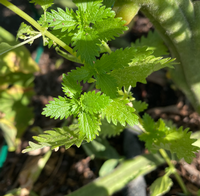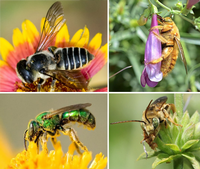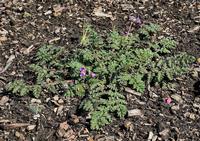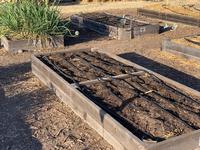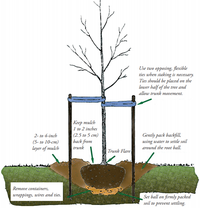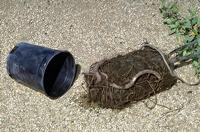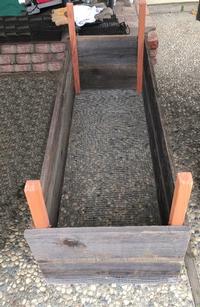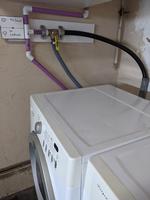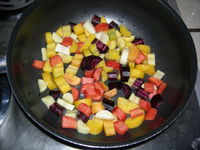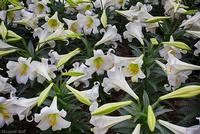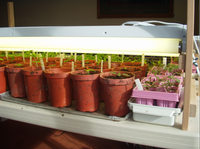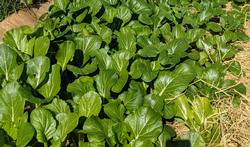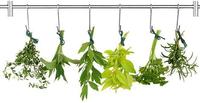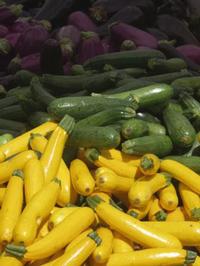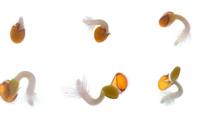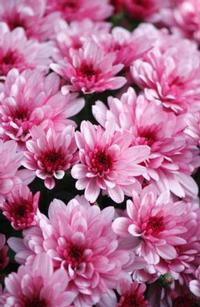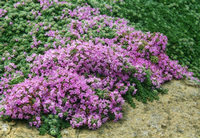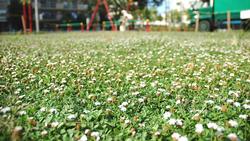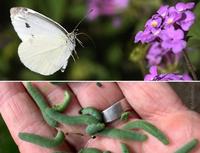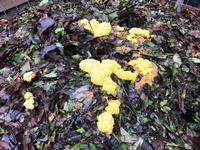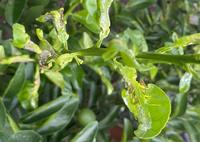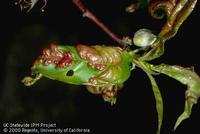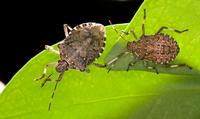April Tips
Monthly tips are categorized by To-Dos, What to Plant, or Pests and Diseases. Scroll through the list to see items in each category. Also, refer to our list of tips useful for any month.
Jump to (links don't work in Firefox):
1. To-do
-
Planting Trees or Shrubs
- You may be tempted to amend the soil when planting trees or shrubs, but it’s no longer recommended. If the soil in the hole is amended, it creates soil moisture differences that discourage the roots from growing into the native soil beyond the hole. For best results, dig a hole about twice as wide as the container. Rough up the sides to help the roots penetrate. Don’t loosen the soil in the bottom of the hole or the plant may settle too low. The goal is to keep the crown of the plant slightly above the surrounding soil. Then simply backfill with the native soil from the hole.
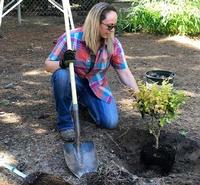
More information: Planting for Success
- March, April, May, September, October, November -
Burning & Stinging Nettles
- Our gardens are pleasant places but not if you find burning nettle (Urtica urens) or stinging nettle (Urtica dioica) among your flowers or vegetables. You’ll know they are there if you brush against them and immediately feel a burning or stinging sensation. Leaves and stems are covered with hair-like tubes that inject an irritating substance when touched. Look for them in late fall and early spring. Remove them as soon as they appear, using gloves for protection. They can produce viable seeds in just five weeks and produce 1,500 seeds per plant. A thick layer of mulch or cover crops with dense canopies can help suppress germination.
More information: Burning & Stinging Nettles
- March, April, October, November -
Irrigation Maintenance
- Check your watering system regularly to make sure it’s working properly. Sprinklers and emitters that are plugged up or misdirected can cause problems for the plants they’re supposed to water, and broken emitters and hoses waste water. Get ready for the growing season by starting a watering cycle for each zone of your controller and visually checking its operation. If you’d like help, Valley Water offers a free evaluation service for properties less than ½-acre in size. Use the link below to schedule a survey. - March, April, September, October
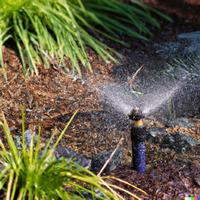
-
Protect Native Bees
- You probably see non-native honeybees in your garden, but do you know there are over 1600 species of native bees in California? These bees don’t make honey, don’t live in hives (most live right in the ground), and are much less likely to sting since they have no colonies to defend. Research shows some species pollinate crops twice as effectively as honeybees, plus they’re best suited to pollinate native plants. But like honeybees, they’re threatened by pesticides and loss of habitat. Help preserve these species by growing a variety of plants that flower at different times of the year and by keeping areas of open ground in your yard.
More information: Native Bees and Their Favorite Plants
Native Bee images, clockwise from top left: Leafcutter bee (Jim McCulloch), carpenter bee (Kathy Keatley Garvey), long-horned bee (Kathy Keatley Garvey), sweat bee (Missouri Department of Conservation Staff)
- March, April, May, June, July, August -
Pinching Flowers and Herbs
- Pinching your flowers and herbs is a way of pruning them with nothing more than your fingertips. Removing the new tender growth at the end of a stem stimulates branching, encourages more flowers, and keeps your garden blooming longer. Follow a stem tip down to the first or second leaf node (where leaves join the stem) and pinch it off just above that node. Two new stems will grow beneath the pinch, resulting in a bushier plant. Early spring—before flower buds form—is the ideal time to pinch. But not all plants should be pinched. In particular, don’t pinch flowers that produce only one flower per stem.
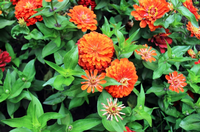 More Information: Pinching Flowers and Herbs- April, May, June, July, August
More Information: Pinching Flowers and Herbs- April, May, June, July, August -
Fruit Thinning
- Fruit trees often set more fruit than they can support, resulting in small fruit and sometimes limb breakage. Peaches, plums, apricots, apples, pears, kiwifruits, and persimmons almost always need to be thinned. Thinning too late reduces the chances that remaining fruit will achieve full size. Remove excess fruit when they are about ½–1" in diameter. Apricots and plums should be thinned to 2–4" apart; peaches and nectarines to 3–5"; for apples and pears, leave one to two fruit per cluster.
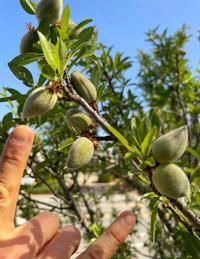 More Information: Thinning Young Fruit- April, May, June
More Information: Thinning Young Fruit- April, May, June -
Time to Prune Frost Damage
- When there is still a danger of frost, we recommend leaving frost damage on plants so it provides protection to undamaged parts. Once the cold winter weather is behind us, it's time to prune frost-damaged plants. Pruning it off would stimulate tender growth that is susceptible to frost. Although the typical last frost date will vary depending on your location within the county and its microclimate, it’s time to start the spring cleanup soon.
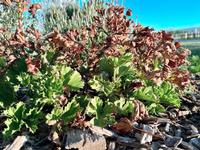 Frost damage on pelargonium
Frost damage on pelargoniumMore information: Treating Cold-Damaged Plants
- March, April -
Weed Spotlight - Filaree
- You may have noticed a highly prolific, rosette-shaped weed lately. Filaree (Erodium spp.) plants start out as low growing plants that can form a dense mat in open areas. They create bright pink flowers that turn into angled seed pods resembling a stork's head and beak, giving the plant one of its common names: storksbill. The spiral-shaped seeds explode out from the plant in late spring, drill into the soil with changes in humidity, and germinate with next year's rains. Recommended control methods include hoeing, hand pulling, and several inches of organic mulch.More information: Filaree- April, May, June, Any month
-
Support Your Vegetables
- Save garden space by providing good support systems for climbing or vining vegetables like tomatoes, pole beans, and cucumbers. Growing vertically also keeps plants healthier by improving air circulation, increasing sun exposure, and keeping fruits off the ground. Even shorter plants like peppers and eggplants benefit from support since heavy fruits can cause unsupported branches to break. There are many possible choices, from commercial cages and stakes to creative reuse solutions. It’s best to install the supports at planting time to avoid damaging the roots or breaking the stems of your new plants.
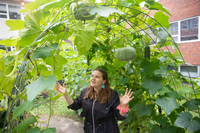
More Information: Trellising, Staking, and Caging
- February, March, April, May, June -
Picking and preserving oranges
- By now, you may still have a lot of navel oranges on the trees. Valencia oranges are harvested through summer. For the rest, rather than leave it to rot or be eaten by rats, pick what is left soon. Even the ones that don’t fall will not stay good forever. The skin may start to ripple as the fruit inside starts to dry and suffer in quality. You can store them in the refrigerator for several weeks, but keep an eye out for mold. You can freeze orange sections for later use in orange juice or smoothies, or you can make marmalade or other orange recipes if you have already eaten enough fresh oranges. Picking the remainder allows the tree to put more energy into the current blossoms which will become next year’s fruit.
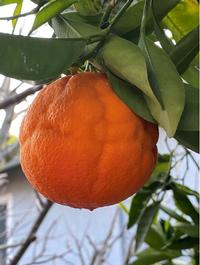 More information: Storing and Preserving Oranges- April, May
More information: Storing and Preserving Oranges- April, May -
Transplanting Vegetables
- As vegetable seedlings start to outgrow their pots, you can transplant them into larger pots, raised beds, or the ground. Make sure the seedling is well-watered before moving it. To remove the plant, either turn the pot upside down — with your other hand positioned to catch it! — or pull the entire root ball out with a fork or other utensil. Be sure never to handle the seedling by the stem, with its vascular tissue that conducts water and food. If the roots are packed together or circling, gently pull them apart. Then gently move the plant to its new home, lightly packing the soil around it. Make sure the soil is at the same level on the stem as in its original pot, except for tomatoes and peppers which can be planted deep. Immediately water thoroughly. A little fertilizer can also be added when transplanting. Transplant shock can be minimized by not changing too many conditions at once, e.g., temperature, wind, or sun exposure.
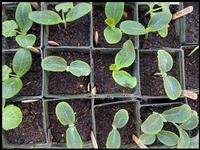 More information: Vegetable Planting Handbook (Los Angeles Master Gardeners)- February, March, April, May, June, July, August, September, October
More information: Vegetable Planting Handbook (Los Angeles Master Gardeners)- February, March, April, May, June, July, August, September, October -
Garden Planning in a Drought
- Even when we get good winter rains, our summers are dry. So, water-wise garden planning is always a smart choice. We can prioritize the plants with more value, including food production or a long-term investment. If your existing plants are crowded, consider removing some so they don’t compete for water. This is a great time to get rid of any that you don’t really like. Why waste water on them? Don’t add new plants to your landscaping while we remain in a severe drought. Even drought-tolerant plants and California natives need extra water to get established.
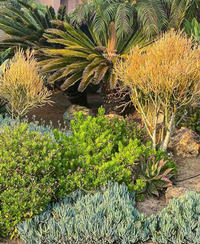
More information: Drought: Gardening Tips
- March, April, May, June -
Drought Tip - Irrigate Efficiently
- Water restrictions are being put into place all over the state due to the current drought. With over half of urban water used in landscapes, it is essential to make sure your irrigation system is efficient. Watch your plants for signs of underwatering, overwatering, or uneven watering. Consider reducing irrigation times. And make sure your water bill hasn’t unexpectedly jumped. Also, adjust systems on timers monthly as the weather changes or use an automatically-adjusting smart controller. A smart controller can make the needed adjustments after initial programming with plant, location, and other relevant information. Our Santa Clara County clay soil absorbs water slowly, so only water for a few minutes at a time to avoid runoff. Then repeat until the water penetrates to the depth of the roots. Inspect drip and sprinkler systems regularly to make sure there are no leaks, emitters are not clogged and it is watering the plants and not the sidewalk, also make sure the water is going to the root zones of the plants. If you run a hose to a plant, set a kitchen or cell phone timer so you don’t forget that the water is running. Valley Water can help residents with Water Wise Outdoor Surveys and Landscape Rebate Programs.
More information: Irrigation System Audit
- March, April, May, June, July, August, September, Any month -
Drought Tip - Lawns
- This landscaping feature—imported long ago from rainy, foggy England—does not translate well to a semi-desert with frequent droughts. Lawns demand a huge investment of water, money, time, work, equipment, and fertilizers and other chemicals. According to Scientific American, U.S. lawns require the equivalent of 200 gallons of drinking water per person per day. Many people are joining the "lose the lawn" movement, and UC Davis offers several plans and examples to help you get started on a yard design more appropriate for our climate. Valley Water offers rebates and guidance for lawn replacement. If your family uses your lawn and you want to maintain it this summer, follow the irrigation regulations of your local water company and aim for survival rather than a lush green carpet. A lawn that looks light green or brown will often be dormant (not dead) and will perk up with the winter rains; the roots can survive much longer than the blades above ground. Keep it mowed in the meantime so that weeds don’t go to seed and take over. Concrete and synthetic (plastic) turf do not benefit the environment other than not using much water.

More information: Drought Resources
- March, April, May, June, July, August, September, Any month -
New Trees Staking
- Not all new trees even need to be staked. Only stake if necessary for protection, anchorage, or support. Don't place the stakes too close to the trunk of the tree. Place stakes on opposite sides of the tree, outside the root ball. Make sure the stakes don’t rub on the trunk or branches. Ties should be added no higher than necessary to support the trunk. This allows as much freedom to move as possible, and movement builds trunk strength. Inspect the tree regularly to make sure there’s no damage. Remove the ties and stakes when the tree can stand on its own, generally after a year or so.
More Information: Tree Staking- January, February, March, April
-
Inspect Roots When Planting
- If you’re adding plants to your garden this spring, check the roots before putting them into the ground. Two things are particularly important. First, look for circling roots, which can eventually strangle the plant. Straighten them out as much as possible and consider pruning them if they’re too big to spread. Second, note where the roots start growing and plant at that depth, or slightly higher to allow for some settling. If planted too deeply, plant roots cannot get enough oxygen to grow and may suffocate and die. Planting too shallow can result in root damage from exposure and excessive drying.
More Information: Fix Those Roots Before You Plant
- February, March, April, May, September, October, November -
Raised Beds
- Raised beds make gardening easier in several ways. You don’t have to bend over as far to reach the surface. You can add any soil blend you like and you won’t compact the soil around the roots by walking on it. You can also better protect the roots and plants from critters. You can build them with wood or cinder blocks or anything that doesn’t have chemicals that can leach out into your food, for example, no pressure-treated lumber or railroad ties with creosote. If you’re using wood, redwood and cedar are the most resistant to pests and rot. You can be particularly green by using old fence boards or decking. Locate the beds where the plants will get the sun they need. Make sure the width is not more than twice your arm length so that you can easily reach all parts from the sides. To prevent gophers and other pests from tunneling into the root area, line the bottom of the bed with hardware cloth.More Information:
- Gardening in Raised Beds (Page 7)
- Raised Beds in Vegetable Gardening Basics
- Quick and Easy Raised Bed Design
- March, April -
Prevent Fruit Tree Sun Burn
- Summer sun can bake trunks and branches of trees, especially when pruned to allow light into the tree’s center. Use whitewash to protect the bark from sunburn and subsequent insect infestation. Coat the south/west facing sides of the trunk and the top of main, sun-exposed limbs of all young trees and on older trees pruned to allow sunlight to reach the tree interior. Use white interior latex paint diluted to half strength with water. Apply the paint mixture from the soil surface up the entire trunk (and 2 inches below the surface for newly planted trees). Smaller branches are usually naturally protected by the tree’s leaves.
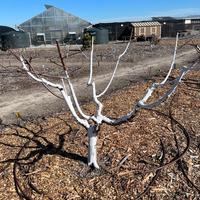 More information: Care for Young Fruit Trees- April, May, June, July
More information: Care for Young Fruit Trees- April, May, June, July -
Potting Mix vs Planting Mix
- Is there a difference between potting mix, potting soil, and planting mix? The best advice is to read the label. The terms for bagged mixes aren’t regulated, so they can vary by manufacturer. What’s important to know is that not all bagged mixes can be used in pots. Some are meant to be used as garden fill, amendment, or mulch, so they won’t provide the right water retention, drainage, or nutrients for container gardening.
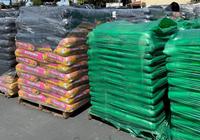
For more information: Bagged Potting Mixes
- March, April, May, November -
Weed Spotlight - Spotted Spurge
- This annual weed is native to the eastern US but is now common in home gardens here in California. Spotted spurge germinates at temperatures as low as 60ºF and is often found in open areas, sidewalk cracks, and thin lawns. It forms a dense mat of foliage that grows radially from a central taproot. Left unchecked, each plant can grow to 3' across and can produce thousands of seeds. The seeds need light to germinate, so a 2" cover of mulch usually provides effective control. Pull weeds when you see them, removing the root to prevent regrowth. Use gloves to avoid contact with the white sap which can irritate skin.
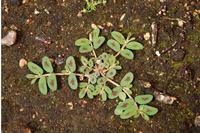 For more information: Spotted Spurge Management Guidelines- March, April, May, June, Any month
For more information: Spotted Spurge Management Guidelines- March, April, May, June, Any month -
Drip Irrigation
- Consider various forms of irrigation conversion! Irrigation systems, especially drip and micro-sprinklers, have drastically improved over the last few years. For example, there are kits that convert pop-up sprinkler heads to low-flow systems. The conversion kits include a pressure regulator to control changes in pressure and a filter to improve water quality. Water usage is reduced through better water management, control of distribution and less loss from evaporation. Other advantages include :
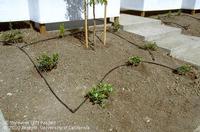 Low volume drip irrigation system
Low volume drip irrigation system- Water is placed more accurately and efficiently in the root zone, it is applied at a slow rate that reduces loss from runoff.
- Dry soil between plants allows you to work in the garden between irrigating.The key to success is watering long enough to supply adequate water to the root zone. Inappropriate watering commonly damages landscape plants. As with any irrigation system, they are efficient only when soil around the plants being irrigated is regularly monitored for proper moisture levels (Reference: UC Pest Note Poor Water Management, Poor Drainage).
- April, May, June, July, August, September, Any month -
Tomato Staking
-
It's time to start planning how you will stake your tomatoes. You will want to stake your tomatoes right after you plant your seedlings. Here are the various Tomato Staking Techniques we have tried.
- April, May, June -
Soil Management - Compost vs Mulch
-
Many home gardeners are confused about the terms “compost” and “mulch;” frequently these terms are used interchangeably, but they are not really the same thing. Here is a Comparison of Soil and Mulch from UCCE.
Amend soil with compost to create soil that will retain water but still drain well enough for roots to have the air and water they need.
Benefits of compost
- Forms aggregate particles with clay
- Creates larger pore spaces for water & air
- Helps release nutrients from clay so that plant roots can absorb them
- Supports the soil foodweb by providing nutrients for the organisms
- Lowers pH somewhat.Benefits of mulch
Mulch does not get worked into the soil. It sits on top of your irrigation system and helps:- Control weeds
- March, April, May, Any month
- Prevent erosion
- Preserve soil moisture
- Keep roots cool and moist -
Keep Foliage after Bloom Fade
- To keep bulbs/corms/rhizomes/tubers blooming each year, leave the plant’s foliage in the ground long after the blossoms have withered. That’s because the foliage needs to photosynthesize to store energy in the bulb for next year’s blooms. Deadhead the spent flowers by cutting the stalks from the finished blooms all the way back to the base, Then wait for the foliage to die back and turn yellow before removing it. Some people tie the leaves together to tidy the garden, but that’s not advised because it limits the light needed for photosynthesis. As an alternative, intersperse annuals to hide the foliage until it can be removed.
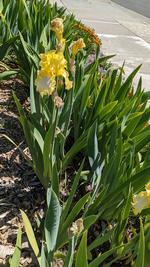
If the plants seemed crowded and the flowers were getting smaller, carefully dig them up, separate the bulbs, and replant them with greater spacing. Toss any bulbs/corms/rhizomes/tubers
that are mushy or show other signs of rot. And continue to enjoy easy-maintenance flowers year after year. More information: Basic Bulb Care
- March, April, May, June -
Pruning Azaleas and Rhododendrons
-
Azaleas and rhododendrons can be pruned as soon as they finish flowering. This is also a good time to fertilize them. Choose an acid-forming fertilizer blended for these particular plants, and be sure to follow the label directions for amounts. Learn more by visiting the Azalea and Rhododendron society websites.
- April, May -
Drought Tip - Laundry to Landscape Irrigation
- A laundry to landscape system is an easy way to save water in times of drought. It can be installed easily at a low cost to send rinse water from clothes washers directly to the landscape.
Suitable plants include fruit and ornamental trees, shrubs, and ornamental annuals. It’s not applicable where the water would come in direct contact with fruits or vegetables.
More information: Laundry-to-Landscape Graywater System
- March, April, May, June, July, August, September, Any month -
Remove Thatch in Lawns
-
If you have a lawn, April is the time to remove thatch. Thatch is a layer of dead and living stems, roots, stolons, and rhizomes, between the green blades of grass and the soil surface. If thatch becomes too thick, it can keep water, air, and nutrients from reaching the soil and roots. Thatch can be removed with a thatch rake to improve the health of the grass. The UC Guide to Healthy Lawns has more information.
If you are tired of mowing and raking and watering that lawn, you may want to check on the Santa Clara Valley Water District's Landscape Rebate Program. Even if the funding is used up for the year, you can still replace your lawn to conserve water, time, and energy. But don't start by digging it up. Instead, sheet mulch the area. Then you can add drought-resistant native plants or ground cover, such as yarrow, thyme, sage, creeping manzanita or ceanothus.
- April -
Pruning Dead Branches
-
As dormant trees and shrubs begin to leaf out, it will be fairly easy to see which parts are dead. Prune back to live wood to avoid diseases and keep your garden healthy. Swelling buds and a thin green layer just under the bark are signs that the wood is alive. Find tips on pruning at the UC Home Orchard website. If larger trees need pruning, hire a professional. The International Society of Arboriculture (ISA) has a searchable list of certified arborists.
- March, April -
Pruning Bougainvillea
-
You can prune at any time to shape or direct growth. If it is growing on a wall, cut back long stems to keep producing flowering wood. Hard pruning to renew the plant should be done in the spring after the last frost.
- April, Any month -
Pruning Fuchsias
-
The time to prune fuchsias is early spring, after the chance of frost is past. If there is frost damage prune it out and take off some of last summer's growth. Leave at least two or three healthy leaf buds on each branch. Fuchsias have a tendency to get leggy. Frequently pinch the tips of the branches during the spring and summer to force side growth, making the fuchsia bushier. Pick off flowers as they fade.
More information: UC IPM list of common pests and disorders of fuchsias.
- February, March, April -
Pruning Camellias
-
April and May are the best time to prune camellia. Camellia should be pruned just after flowering and before new vegetative growth gets going. If you prune later in the season, you risk damaging next years blossoms.
- April, May -
Growing Vegetables in Containers
-
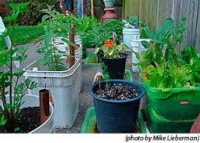 Container grown vegetables can be decorative as well as good to eat. Almost any vegetable can be grown in a container if given the proper care. Eggplant, peppers, tomatoes, lettuce, onions, carrots, cucumbers and herbs do well. Use our Vegetable Planting Chart to decide when to plant.
Container grown vegetables can be decorative as well as good to eat. Almost any vegetable can be grown in a container if given the proper care. Eggplant, peppers, tomatoes, lettuce, onions, carrots, cucumbers and herbs do well. Use our Vegetable Planting Chart to decide when to plant.One of the biggest problems is that containers dry out very fast and nutrients wash away. Both are solvable. Do not use clay pots, which dry out quickly. Plastic, composite or wooden half-barrels are good, but avoid dark colors that can absorb heat. Vegetables like a roomy container.
There must be drainage holes in the bottom but it is not recommended that you put pebbles or broken crockery in the bottom. Use a good commercial potting mix, not planter or planting mix. Group the containers together so they will shade one another.
The hot summer sun can heat the soil to unhealthy levels. Water whenever the soil is dry. You can test by digging your fingers into the dirt. You may have to water more than once a day. A simple drip system is easy to install and will make your container garden almost foolproof. Fertilize every week with a water-soluble fertilizer.
- February, March, April, October, November -
Poison Oak
-
Poison oak is a California native plant that provides shelter and food for many native birds and other creatures. The downside is that at least 75% of us develop allergic contact dermatitis to the plant. Unwanted poison oak can be pulled or dug up by allergy-resistant friends, remove plants in early spring or late fall when the soil is moist and it is easier to dislodge rootstocks.
A complete list of management options, including herbicide control, is contained in the UC Pest Note on Poison Oak. Under no circumstances should poison oak be burned.
- February, March, April, November -
Protecting Birds and Crops
-
This is nesting season for many birds, so be sure to check for active nests before pruning trees. Birds are good for natural pest control, as they eat many insects, and they improve your garden’s biodiversity. You can also encourage birds in your yard by providing food and water for them. Just be sure the water stays fresh and clean.
To protect fruit and nut trees from marauding birds, PVC structures covered with netting can save your crop. If netting is placed directly on the tree, birds will still be able to reach much of the fruit. There's more information in the UC Pest Note on Birds on Tree Fruits and Vines.
- April -
Harden Seedlings
- Seedlings grown indoors or in a greenhouse are tender because they have been sheltered from direct sun and outdoor conditions. You need to acclimate them to the great outdoors, a process called hardening, before planting them into the garden. Start by giving them short exposures to full sun and cool nights, gradually increasing the amount of time. Seedlings can dry out quickly, so be sure to keep them watered, especially with hot or windy weather. Protect them if nights are cold. After about two weeks, they should be ready to start life in the garden.
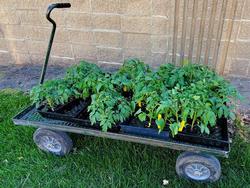
More information: Hardening Transplants
- April, May -
Lady Beetle
- We all know that lady beetles are good for the garden. Make sure you can recognize the larval stage because this life stage eats even more aphids than the adult form. Lady beetles lay their distinctive yellow eggs near a food source such as aphids. The larvae grow quickly, then pupate into the familiar adult form (but there are actually many varieties of lady beetles). It’s better to attract lady beetles to your garden rather than buying and releasing them. Purchased lady beetles generally fly away, and the process of collecting them in the wild is often destructive. To attract lady beetles, refrain from spraying insecticides, grow flowers that attract beneficial insects, and leave some aphids for them to eat.
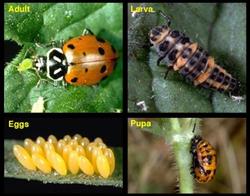 Lady beetles develop through four life stages: egg, larva, pupa, and adult by Jack Kelly Clark, UCANR
Lady beetles develop through four life stages: egg, larva, pupa, and adult by Jack Kelly Clark, UCANRFor more information: Aphid Eaters
- March, April, May, June, July, August -
Young Fruit Trees
- If you have young fruit trees, particularly ones you just planted during bare root season, you want to protect them while they’re still delicate. Water them regularly while they are establishing their root system. Put mulch around the root area to hold in moisture, moderate the soil temperature, and help keep weeds from sprouting and competing for water and nutrients. Consider painting the trunk with white latex paint, diluted 50% with water. This will reflect the sun and help prevent sunburn. Sunburn is a problem because the bark can crack, allowing pests and diseases to enter the wood more easily. Once the tree is larger and has a full canopy, the leaves will normally provide sufficient protection.
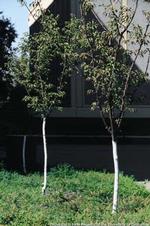
More information: Video: Getting Fruit Trees off to a Good Start (88 min)
- April, May -
Container Color Choice
-
If you are growing plants in containers, keep in mind that light colors do a better job at reflecting the sun. This helps keep the soil from drying out too quickly and reduces the chances of the roots burning. If you already have dark pots, consider painting them a lighter color, or be especially careful about watering.
- April, May, June, July -
Empty Standing Water
- Make sure you don’t have any water sitting around from our late rains. Mosquitos breed in standing water and can pass along deadly West Nile Virus to people. Check and dump water from any buckets, pots, saucers, dishes, or wheelbarrows. Put containers away or turn them over to avoid collecting additional water. Keep chemicals balanced in swimming pools. Ponds, fountains, and bird baths can also be breeding grounds. Add mosquitofish to these bodies of water to eat mosquito larvae. They are an environmentally friendly means of control and are available free of charge from Santa Clara County Vector Control.
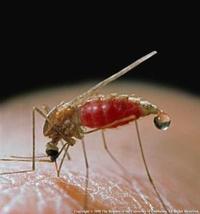
More information: Empty Standing Water Video
- March, April, May -
Yellow Leaves on Citrus Trees
- While there are several possible causes for yellow citrus leaves, the most likely one in winter/early spring is that citrus roots do not absorb nitrogen efficiently from cold, wet soils. There may be adequate nitrogen in the soil, but the roots aren’t able to take it up. However, if the tree doesn’t green up when the weather warms, give it some nitrogen fertilizer, up to 1 lb of N per year for a mature, full-size tree. Dwarf trees or ones in containers require less fertilizer, 1/2 lb of N or less. Do not overfertilize since that may cause other problems.
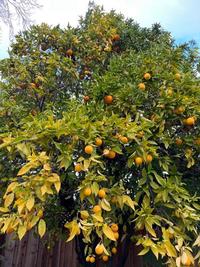
More information: Growing Great Citrus
- January, February, March, April -
Should You Prep Soil for Planting?
- It’s tempting to grab a shovel and turn over all the soil in your garden as you prepare for summer planting. But should you? Increasingly, science is saying “no.” Every time you dig into the soil, you’re disturbing a very intricate, living web of organisms, bacteria, and fungi that your plants need to thrive. In contrast, a “No-Till” approach minimizes soil disturbances and keeps organic material like leaves, compost and coarsely chopped plants on the ground’s surface to slowly decompose. By keeping it moist and protected from beating sun and pounding rain, this organic material allows the soil to stay crumbly and ideal for planting.
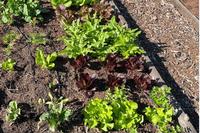
More information: No-Till for Home Gardeners
- March, April, May, October, November -
Broccoli - Multiple Harvests
- Did you know that most broccoli plants can give you multiple harvests? The first central head that they produce will be the largest and fullest. But after you harvest that one, the plant will start to produce lots of smaller heads, called side shoots. They sprout from buds in the leaf axils, where the leaves join the stem of the plant. You can keep harvesting these tender shoots, sometimes called broccolini or baby broccoli, for another 2 to 3 months.
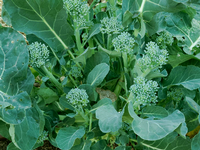
More Information: Growing Broccoli
- March, April, May, June, September, October, November, December -
Weed Spotlight - Bindweed
- Have you seen a pretty, morning glory-like flower on a vine that winds through any plant within reach? Field bindweed is one of the most challenging weeds to control because its roots can reach depths of 20 feet or more and it readily re-grows from root fragments as short as 2 inches. The only chance of controlling this invasive weed is to stay right on top of it and remove it as soon as you see any of it peeking up out of the ground. Every time it starts growing above ground and photosynthesizing, it is storing energy in the roots. This allows it to put out new shoots. It produces many seeds which remain viable for years. Making things even worse, it’s drought tolerant. Controlling it isn’t easy, but the UC pest note below discusses options. Chemicals aren’t needed if you’re persistent in removing new growth to prevent seed production and limit the plant’s ability to store new energy in the roots.
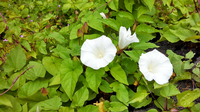
For more information: Field Bindweed Pest Notes
- March, April, May, June, July, August, September, Any month
2. What to plant
-
Fresh Cut Flowers from Your Garden
- We have a webpage to help you choose and grow beautiful cut flowers for your home or to give away. The Cut Flower Planting Chart lists ornamentals we’ve grown successfully. We selected these for their hardiness, appeal to pollinators, and production of good cutting flowers. The chart tells you when to start these flowers from seeds or when to transplant, plus when you can expect to see blossoms.
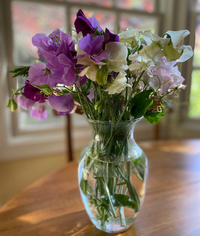
More information: Tips on planting a cut flower garden
- January, February, March, April, May, June, Any month -
Plant Cool Season Vegetables again
- Salad greens, carrots, beets, fennel, broccoli, and bok choy are just a few of the vegetables that you can plant now. The warming weather and longer days will help them mature quickly. By the time they’re done, it will be warm enough to plant summer vegetables like tomatoes and peppers. You can direct seed into the garden or get a head start by transplanting seedlings. Use our vegetable planting chart for a full list of suggestions. - February, March, April
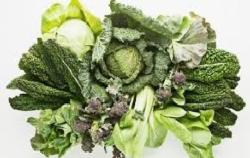
-
Growing Purple Carrots
- If you only buy carrots at the supermarket, you may think that they are all orange. It is believed that carrots were originally purple, with orange becoming popular through Dutch breeding. Several colors are now available at Farmers’ Markets and by growing your own. Springtime is a good time to start carrots from seed. Transplanting is not advised because you can easily damage the roots which are the relevant plant part. Loose soil is important so that the carrots will grow straight. Scatter the seeds over the soil with as thin a covering as possible, keep moist until germination, and harvest when the tops expand to a good size. The Master Gardeners have done germination and growing experiments with different varieties and soil blends. Covering seeds with a thin layer of vermiculite yielded the fastest and highest rate of germination. Carrots are slow to germinate and could take as long as 3 weeks. Thin to 2 or 3 inches apart. For growing, a soil blend of 1/3 compost and 2/3 soil produced higher-weight carrots than blends with half of the soil replaced with either sand or perlite.
Some common problems are twisted roots from planting too close together, forked or deformed roots from clods and rocks in the soil, a hairy root from too much nitrogen and splitting from too much water.
More Information: Growing Carrots
- February, March, April, September -
Easter Lilies
- Beautiful white Easter lilies are normally everywhere this time of year – in nurseries, on Easter dinner tables, and in churches. How do they all come into bloom every year just in time for the moveable Easter holiday? The blooms are forced in commercial growing operations with greenhouses carefully controlled for temperature, light, and moisture. 95% of the bulbs are started in ten farms along the California-Oregon border. The plants are native to Taiwan and Japan and were first described in a Japanese gardening book in 1681. You can plant them outdoors after Easter in moist, well-drained soil with partial sun. Their natural cycle will lead to blooms closer to June in subsequent years. Just don’t let your cats eat them!More Information: Easter Lily diseases- April
-
Attracting Bees
-
Bees are pollination workhorses, increasing garden production. Many plants will not produce fruit unless flowers are pollinated. Colorful annuals, such as Cosmos, edible African Blue Basil, and Salvias attract bees. You can also allow herbs and other plants to flower to create bee-friendly landscapes.
The University of California at Davis has a garden dedicated to bees. The Honey Bee Haven website has more resources, including a list of plants they grow.
- March, April, May, June, September, October -
Don't Plant an Invasive Plant
-
According to PlantRight, so-called invasive plants "escape into open landscapes and cause a variety of ecological problems. They displace native plants and wildlife, increase wildfire and flood danger, clog valuable waterways, degrade recreational opportunities, and destroy productive range and timberlands."
PlantRight has identified the following as invasive in Northern California: Green fountain grass (Pennisetum setaceum), Periwinkle (Vinca major), Pampas grass (Cortaderia selloana), Highway iceplant (Carpobrotus edulis), Mexican feathergrass (Stipa / Nassella tenuissima), Yellow Flag Iris (Iris pseudacrorus), Water Hyacinth (Eichhornia crassipes).
With just a little research you can avoid using plants that are unfriendly to the Bay Area.- April, May, June, July, August, September -
Arboretum All-Stars
- UC Davis, known for its horticulture expertise, has its own roster of 100 top-performing plants to consider for your garden. To make the cut, each Arboretum All-Star must be attractive for most of the year, thrive in California’s Mediterranean climate, and be thoroughly tested at the UC Davis Arboretum. To see them in person, take a day trip to the Arboretum – it’s open and free to the public. Or access their searchable database and find the perfect All-Stars for your specific garden conditions, along with planting plans and where to buy them.
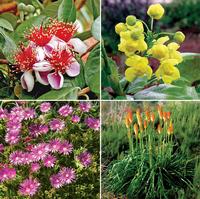 Clockwise from top left: pineapple guava, compact Oregon grape, Christmas cheer poker plant, Cooper’s ice plant, UC Davis Arboretum
Clockwise from top left: pineapple guava, compact Oregon grape, Christmas cheer poker plant, Cooper’s ice plant, UC Davis ArboretumMore Information: UC Davis Arboretum All-Stars
- April, October, Any month -
Growing Transplants from Seeds
- Many summer vegetables can be started now from seed indoors or in a greenhouse. The ground is still too cold for summer seeds to germinate or for the plants to go into the ground. Depending on the weather we get this spring, it will likely be May or June before the soil is warm enough. The soil in containers or raised beds will warm up earlier in the season.
Starting plants in pots will give them time to get stronger before putting them near potential pests. It will also allow you to continue enjoying current cool-season vegetables.
Information found on the seed packages will show which conditions are best for germination. Peppers in particular germinate best with high soil temperature. Using a heating pad is one way that this can be done indoors.
Be sure to provide light once the seeds germinate if the seedlings are not in natural sunlight. Seedlings with insufficient light will grow tall and thin and leggy and will not be as strong.
When reusing pots for seed starting, prevent the spread of plant diseases by making sure they are clean. Remove any remaining soil and cobwebs; then clean with a 10% bleach solution: 1 part bleach to 9 parts water.
If they are growing too large for the pots they are in, transplant them into larger pots. The same can be done for seedlings purchased from a nursery. Transplant them on the ground as suggested under "when to plant" for each vegetable tomatoes, peppers, cucumbers, squash, and melons.
This video provides more details on raising your own seedlings.
- February, March, April -
Plants to Attract Butterflies
-
Butterfly populations fluctuate in response to climate and habitat conditions. Many have specific host plants on which they feed and breed. Some common plants for attracting butterflies are milkweed, lantana, buddleia, and zinnias. For an extensive list of relationships between specific butterflies and host plants, see Art Shapiro's Butterfly Site at UC Davis.
- March, April, May, June -
Asian Vegetables
- You can easily grow some vegetables used in different types of Asian cuisine and found in Asian markets. They are not necessarily native to Asia but have found their way into various cuisines. One way to decide which food to grow yourself is to choose varieties that aren't readily available or are more expensive in your local markets. It’s also fun to impress your family, friends, and neighbors with something they may not have seen growing before. Possibilities include sesame seeds, bitter melon, opo, sigua (loofah) in summer and bok choy, napa cabbage, daikon radishes, gai choy in spring or winter.- February, March, April, May, June, September, October
-
Herbs
- Many herbs can be grown both indoors and out, in pots or in the ground. Rosemary grows large and needs to be in the ground or a big pot. If you use basil to make pesto, you may want a row of it in the garden. Yet most herbs tend to be used in small quantities for seasoning and so they can be grown in small containers. They can be on the kitchen counter or a windowsill for ease of use in cooking. They can be on a patio if you are in an apartment or condo. And they are well suited to container gardening outdoors. Woody herbs can be grown from cuttings, lemongrass can be started from stalks from the store, and most others can be started from seed. After harvesting, many can be dried as well as used fresh.More Information: Growing Herbs- March, April, May, September, October
-
High Yield Vegetables
- There are many considerations for choosing which edibles to plant in your garden. A particularly important one this year may be high yield. The more the plants produce, the more food you will have right on your property. Zucchini naturally comes to mind first. You may need to research additional recipes, and your neighbors may be more amenable this summer to having bags of zucchini dropped on their doorsteps during the night. Other plants that produce a lot are tomatoes and eggplant. Green beans need to be picked almost daily so they will give you an ongoing source of vegetables for a couple of months. Certain cucumbers like Persian cucumbers are eaten small and produce prolifically, enabling you to eat cucumbers more often than if you were waiting for full-size varieties. Vining plants, e.g., melons, will give you more to eat if grown on vertical supports rather than having the produce lie on the ground where it can be more readily eaten by pests.- April, May, June
-
Seed Viability
- Seed packets have a “packed for” date on the back. Yet seeds can still be viable for years beyond that date if stored correctly. Ideal storage conditions are cool and dry. The older the seeds are, the lower the germination rate will be. So plant more of the older seeds than the number of plants you ultimately want. You can do a germination test by putting seeds on a damp paper towel and enclosing them in plastic to keep them uniformly moist. Do this right before planting time so you can transplant the ones that successfully germinate. Or you can take your chances and just plant them directly and see what comes up. If you are saving your own seeds, make sure to choose seeds from the healthiest plants.
Whenever it's hard to find flower seedlings, if you have some old flower seed packets, you can scatter the seeds randomly in a section of your yard and enjoy whatever flowers.
More Information: Vegetable Seed Viability- January, February, March, April, May, August, September, October -
Camellias
- Camellias can be planted in fall through spring. Since they bloom in winter, choosing a plant now will ensure that you know the color, shape, and size of the flowers with which you will live for many years. Camellias are not native to our area so may need some extra attention in order to grow successfully. Our native clay soil does not drain well so it must be amended for camellias. Our alkaline soil needs to be acidified, and sulfur pellets are one way to achieve this. The plants need some shade and need to be kept moist. Mulch helps hold in moisture, and pine needles, redwood bark, and coffee grounds are all good organic materials that will break down over time and help improve the soil. Pick up flowers as soon as they fall to the ground to avoid the spreading of a disease called Camellia petal blight.
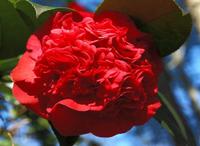
More information: Camellia Pests
- January, February, March, April, May, September, October, November, December -
Chayote
- This mild, green, pear-shaped squash grows on a vine that can produce prolifically for several years. Although it is often recommended to plant it in the spring, some cultures traditionally plant it on Día de la Candelaria, February 2. The seed inside is very soft, so the way to start a new plant is from a whole chayote. Leave the chayote on the counter for a new vine to sprout from the seed within. Then plant it in the ground at a 45-degree angle with the large end pointing downward. The roots will grow from the same end as the shoot. It does best in a sunny location with well-drained soil. Provide strong vertical support from the start because the vine will grow very tall.
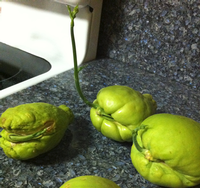 More information: How to grow chayote video- February, March, April
More information: How to grow chayote video- February, March, April -
When to Start Summer Vegetables from Seed
- If you start your seedlings too soon, they can get leggy and overgrown before it’s time to plant them. Tomatoes reach transplant size in 6 weeks, peppers take 8–10 weeks, and cucumbers take just 4 weeks. Plan when you want to transplant into the garden, then calculate backward to figure out when to start seeds. Our vegetable planting chart recommends transplanting tomatoes in May, so start seeds 6–8 weeks before, in March to early April. The hottest varieties of peppers need a long growing season for the pods to ripen. Start peppers earlier, mid-February to mid-March. Wait until May to start heat lovers like cucumbers and melons.
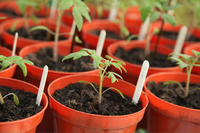
More Information: Growing Transplants from Seed
- February, March, April -
Chrysanthemums
- This is a less common but good time to plant chrysanthemums. They will have plenty of time to develop a good root system before the cold winter and are more likely to bloom perennially in your garden than if they are started in the fall. You can also start chrysanthemums from cuttings. Plant them in amended, well-drained soil, or grow them in a large container. Keep them moist but not wet. They do well in full sunshine, yet a little afternoon shade is fine in hot areas. If you pinch the growing tips as they grow, they will branch and be bushier. Otherwise, be prepared to provide support if they grow tall. Also, pinching off some of the buds will result in fewer yet much larger blooms. There is a Bay Area Chrysanthemum Society for local information and sharing.More Information: Chrysanthemum Disorders and Pests- April, May, June, July
-
Thyme
- Thyme is much more than an herb to season food. In ancient times it was brewed by Egyptians for mummification, bathed in by Greek soldiers for courage in battle, and used by the Sumerians as an antiseptic and antifungal. And if you want a real surprise, check out the active ingredient list on a bottle of Listerine mouthwash. In your own garden it can be used for culinary purposes or as a purely ornamental landscape feature. It grows best in well-drained soil and sunshine, although it will tolerate some shade. It is quite drought tolerant once established. Common/garden thyme (Thymus vulgaris) is an excellent all-purpose thyme, growing to a foot tall and up to two feet wide. Lemon thyme (Thymus citriodorus), with its lemon scent, makes a nice evergreen border. Creeping thyme (Thymus serpyllum) stays short and can be used as a ground cover or between stepping stones. Thyme is attractive to butterflies and bees.More Information: Growing and Using Thyme- March, April, May, June, July
-
Lawn Alternatives
- Do you have a traditional lawn? Would you like something that doesn’t need regular mowing? Something that uses less water? If you’re not ready to completely remove your lawn, walkable alternatives include California native options of red fescue and meadow sedge, as well as other alternatives like white clover, UC Verde buffalograss, Kurapia, Dymondia, and thyme.
For more information: Lawn & Lawn Alternatives
- March, April, May -
Stone Fruit Hybrids
- Plant hybridization is the crossbreeding of different plant varieties. It can happen naturally but more often comes from deliberate work. A goal of hybridization is creating a new plant with the most desirable traits of its parents, such as the sweetness of a peach and the tartness of a plum. There are many different types of stone fruit hybrids. Here are some examples:
- Pluot and aprium: hybrids of a plum and an apricot, named for which fruit dominates.
- Plumcot: a 50–50 hybrid of a plum and an apricot.
- Peacotum: a hybrid of peach, apricot, and plum.
- Nectaplum: a hybrid of a nectarine and a plum.
- Cherum: a hybrid of a cherry and a plum.
- Peacherine and pectarine: hybrids of a peach and a nectarine.
- Nectarcot: a hybrid of a nectarine and an apricot.
These hybrids have had varying degrees of commercial success, and availability may be limited. But development continues, so you may hear of others in the future.More Information: Demystifying Stone Fruit Hybrids- March, April, May, June
3. Pests and Diseases
-
Identifying Beneficial Insects
- A whole army of insects is in your garden ready to help your plants thrive. Pollinators, like bees and butterflies, help plants produce fruit. Lady beetles and lacewings are predators that hunt, kill, and eat insects. And parasites, like certain wasps, develop within a pest’s body and then kill them. Such violence! The trick is knowing which insects are friends or foes. To identify the insects on your own, take pictures of them and any eggs or larvae (check the undersides of leaves). Then zoom in for a closer view and use this site to help you identify beneficial insects.
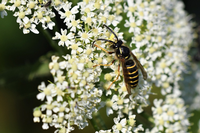
More information: Beneficial Insects
- March, April, May, June, July, August, September -
White Butterflies and Green Caterpillars
- Have you seen these small yellowish-white butterflies fluttering around? Cabbage white butterflies feed on many flowers, but for laying their eggs. They favor the cabbage family, such as broccoli, cauliflower, and mustard. The velvety green caterpillars, also called imported cabbageworms, feed on the leaves after hatching. While mature plants tolerate a few holes munched in their leaves, young seedlings don't have foliage to spare. Cultural controls include handpicking the caterpillars, brushing the eggs off the undersides of leaves, and using row covers to protect the seedlings. UC lists additional options in the link below.
More information: Managing Imported Cabbageworms
- March, April, May, June, July, August, September, October, November -
Slime Molds
- Slime molds come in a variety of colors and shapes. They often appear suddenly and look worrisome. They are fungi and need moisture to grow. According to the Mississippi State Extension, “when slime molds find something to eat, they surround their food and then swallow it. Slime molds may feed indirectly on dissolved substances escaping from organic matter, but they usually feed on microorganisms such as bacteria.” In general, no action is needed. When the area dries out, the slime mold will disappear. Just enjoy this marvel of nature while it’s there.
- January, February, March, April, October, November, December -
Citrus Leafminer
- What causes young, healthy citrus leaves to become gnarled and disfigured and what can be done about it? This damage is due to the citrus leafminer moth that lays eggs on new citrus leaves. Its larvae burrow into the leaf and leave tunnels as they feed, visible as meandering serpentine mines. Our advice: don’t worry about it. Leafminers can slow the growth of young trees but even heavily damaged trees are unlikely to die. Leafminers only attack young leaves — the tough leaves of mature plants resist infestation and fruit is not affected. Damaged leaves still produce food for the tree, so don’t cut them off. If you do, it will stimulate the tree to produce more new leaves — which will attract more leafminers!
More information: Citrus Leafminer
- January, February, March, April, May, September, October, November, December -
Snails and Slugs
- Escargot may sound good on a plate, which is where the French who brought this delicacy to California in the 1850s intended for the ingredients to stay, but they escaped into gardens where they became pests. Brown garden snails are the most common ones we see (or don’t see) eating our plants. Signs of their presence include holes in fruit rinds and leaves, not necessarily at the edges, and slime trails. They tend to hide in dark damp places during the day and come out mostly at night. The best times to find them are at night with a flashlight, early in the morning, or during and right after heavy rain. They can be hand-picked and crushed or put in a bucket of soapy water. Gloves are recommended, especially with the shell-less slugs. Creating hiding places, such as laying a wooden board over a section of the garden, will draw them to that location so you can find and dispatch them in the morning. Copper barriers and beer traps are other options. If you do use snail bait, those made with iron phosphate are not toxic to pets and wildlife.
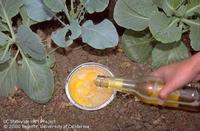
More information: Snails and Slugs
- January, February, March, April, December -
Rat Management
- Have you found a hollowed-out orange or other sour fruit like Meyer lemons with no skins, tomatoes with bite marks, fruit with holes gnawed in them, or grape skins or cherry tomato skins scattered around? It is the work of a roof rat.

Rats show up when your citrus, tomato, or fruit first starts to ripen. Rats are agile climbers and usually live and nest in shrubs, trees, and dense ground cover like ivy. One management strategy is to prevent access to the tree by cutting branches away from fences or other trees, leaving a gap of at least 2–3 feet, good sanitation is required. Garbage and garden debris should be eliminated. Use tight-fitting lids on garbage cans. Thin out dense vegetation to make the habitat less desirable. Mow ivy once a year to the ground. Climbing ivies on fences or buildings should be removed.
Per the UC pest note (linked below), trapping is the safest and easiest method for controlling rats. Read the pest note for other management strategies as well.
More information: Rat Management
- January, February, March, April, July, August, September, Any month -
Citrus Sooty Leaves
-
Sooty mold on citrus may be a byproduct of sucking insects such as aphid, mealy bug, soft scale or whitefly. Ants will protect these pests against predators in exchange for the honeydew that the pests produce. The sooty mold grows on the honeydew. Try washing off the sucking insects with a strong water stream. The next step is control of the ants. Ants may be managed by applying a sticky compound around the trunk and trimming limbs touching buildings or other access points. Baits at the base of the tree also help. For more information about specific controls, see the UC Pest Note on Sooty Mold.
- April -
Peach Leaf Curl Preventive Care
- Have your peach or nectarine leaves ever looked like this? These puckered leaves are a classic springtime symptom of peach leaf curl. Severe cases can substantially reduce fruit production. Prevent this disease by applying a copper-based fungicide shortly after the leaves drop. Use a second application in late winter if there’s a lot of winter rain. Once the blossoms open and leaves appear, it’s too late to do anything. Spraying during the growing season won’t help. If you haven’t seen this on your tree, you may have a resistant variety. If so, there’s no need to spray.
More information: Pear Leaf Curl
- March, April, May -
Avocados, Brown Spot
-
The brown patch that looks like a turtle's back is called Carapace Spot. It is corky and usually cracked into angular divisions. It is caused by rubbing or brushing of tender young fruit on leaves or stems in the wind, but the fruit is usually undamaged under the spot. Just cut out the spot. More pictures of avocado problems can be found on UC Pest Note On Causes of Avocado Fruit Damage.
- April -
Citrus Leaf Drop
-
Leaf drop from citrus trees is normal. Washington Navel oranges may lose over 3,000 leaves a day during peak leaf drop in the spring. Valencia oranges may lose about 1500 a day. Problems that can cause excessive leaf drop beyond these numbers are lack of water and a heavy infestation of spider mites. The tree's leaves will have brown spots if affected by the mites. You can wash them off with a strong water spray. Bud and small fruit drop is also normal. For further information see UC Pest Note on Diseases and Disorders of Citrus Leaves and Twigs.
- March, April -
Oakworm
-
This is a pest of California Live Oaks. The adult oakworm moth is tan-to-gray colored with a wing span of about an inch. It lays white eggs twice a year that turn reddish or brown before hatching. The first hatch is in November and overwinters on the leaves, growing and eating more as the weather warms. At full size, the larva is about an inch long with a yellowish green body, dark stripes down the side and large brown head. Outbreaks occur every eight to ten years in the Bay Area. In late March or April, look for little green pellets (droppings) falling from oak trees. A second generation of eggs hatches in mid to late summer. Trees may suffer no permanent damage beyond being unsightly. If you cannot tolerate the worms and their mess, further treatment methods are outlined in the UC Pest Note on California Oakworm.
- April -
Termites
-
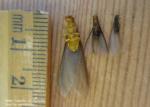 Termites are very common in Santa Clara Valley. The first sign of infestation may be the presence of winged forms or fecal pellets pushed out of the infested wood.
Termites are very common in Santa Clara Valley. The first sign of infestation may be the presence of winged forms or fecal pellets pushed out of the infested wood. See the UC Pest Note on Termites to identify which type is present and the methods of control. Learn all you can before calling in the professionals.
- April, November -
Brown Marmorated Stink Bug
- Native to Eastern Asia, this pest was introduced to the United States in the 1990s and has been established in Santa Clara County. Some features to distinguish these bugs from other stink bugs are white stripes on the antennae, a blunt head shape, and smooth shoulder margins.
They feed and reproduce on a variety of plants and are particularly damaging to fruit. You can cut cosmetic damage off fruit and still eat the rest of the fruit. To keep out stink bugs, cover vegetable plants with row covers. You can pick the bugs off plants and squish them or knock them off into soapy water. They are attracted to light and can get into homes where if vacuumed up, they can stink up your vacuum bag.
More Information: Brown Marmorated Stick Bug Pest Note- March, April, May, June, July, August, September -
Fire Blight
- This disease is so named because brown or black leaves, fruit, and branches look as if they have been burned. It is most common on apple and pear trees. Late spring and early summer are the time fire blight shows itself.
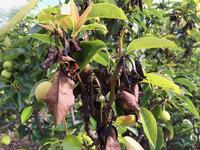
It is spread by insects, rain, or pruning. The bacteria enter through the blossoms and travel down the tree. If left unchecked, fire blight can enter the trunk and kill the entire tree. Prune infected branches back to healthy wood, at least eight inches below visible damage. If the inside of the branch is discolored, you need to cut back still further. Clean pruning tools between cuts so as not to spread the infection. A less effective way to control fire blight is to spray the open blossoms with a copper spray. Planting varieties that are less prone to fire blight is helpful. Always promptly clean up fallen fruit and leaves.
For more information, see the UC Pest Note on Fire Blight.
- April, May, June -
Today’s Grubs Are Tomorrow’s Beetles
- The white grubs commonly found in lawns and gardens hatch into masked chafers and green fruit beetles. Masked chafer grubs are about 1 inch long and are mostly found in lawns. They feed on roots, so a large population can cause dead patches. You may also see lawn damage from animals digging for these tasty treats. The green fruit beetle grub is much larger, about 2 inches long, and is found in compost or garden beds high in organic matter. The grubs don’t damage plants, but the iridescent beetles feed on fruits. Finding an occasional grub is no cause for worry. Just leave them out for birds to feast on.
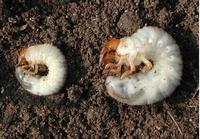 Photo credits, Left — masked chafer larva (David Cappaert), Right — green fruit beetle larva (Bugwood.org)
Photo credits, Left — masked chafer larva (David Cappaert), Right — green fruit beetle larva (Bugwood.org)More Information: What are White Grubs?
- April, May, June, July, August, September, October








